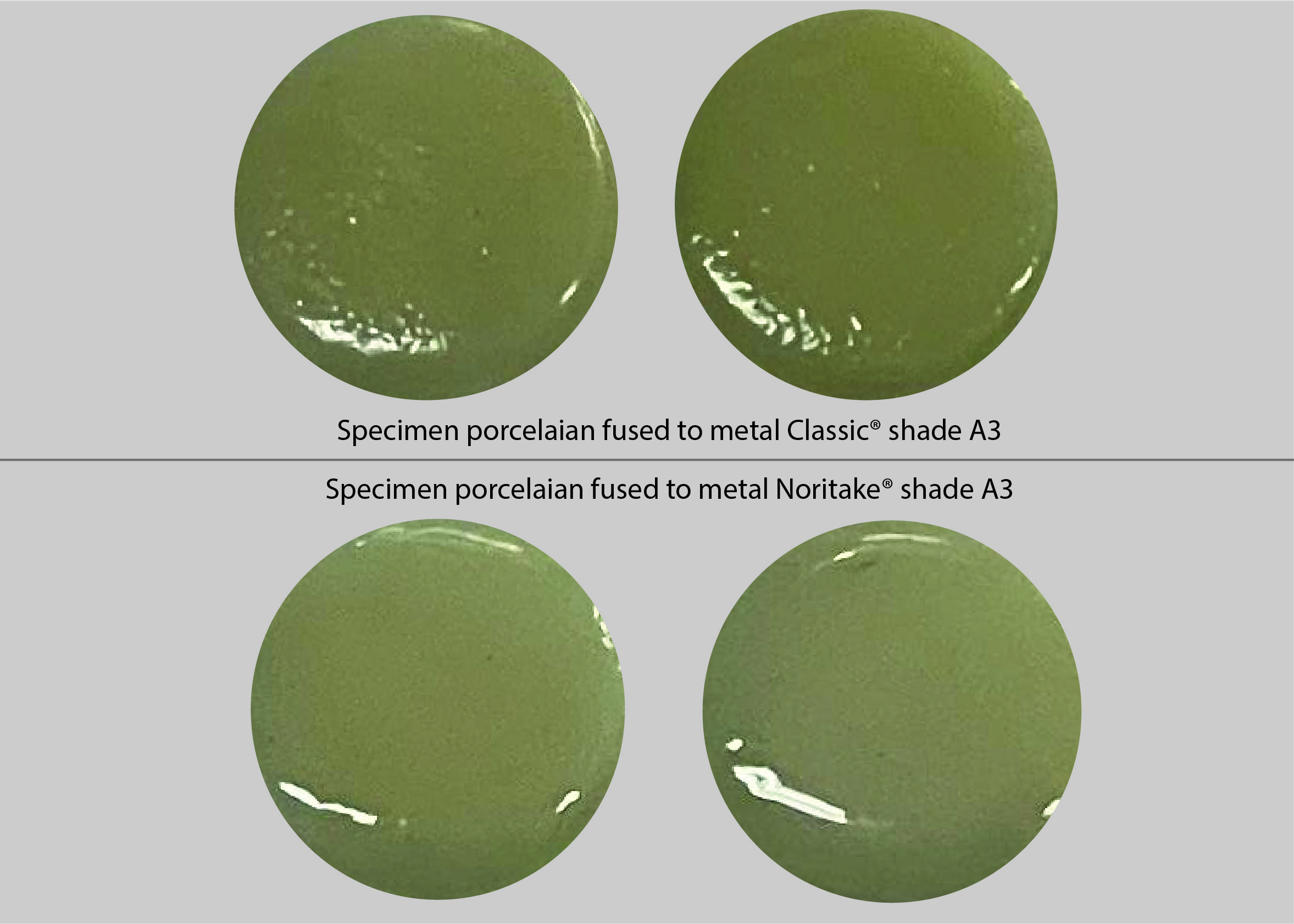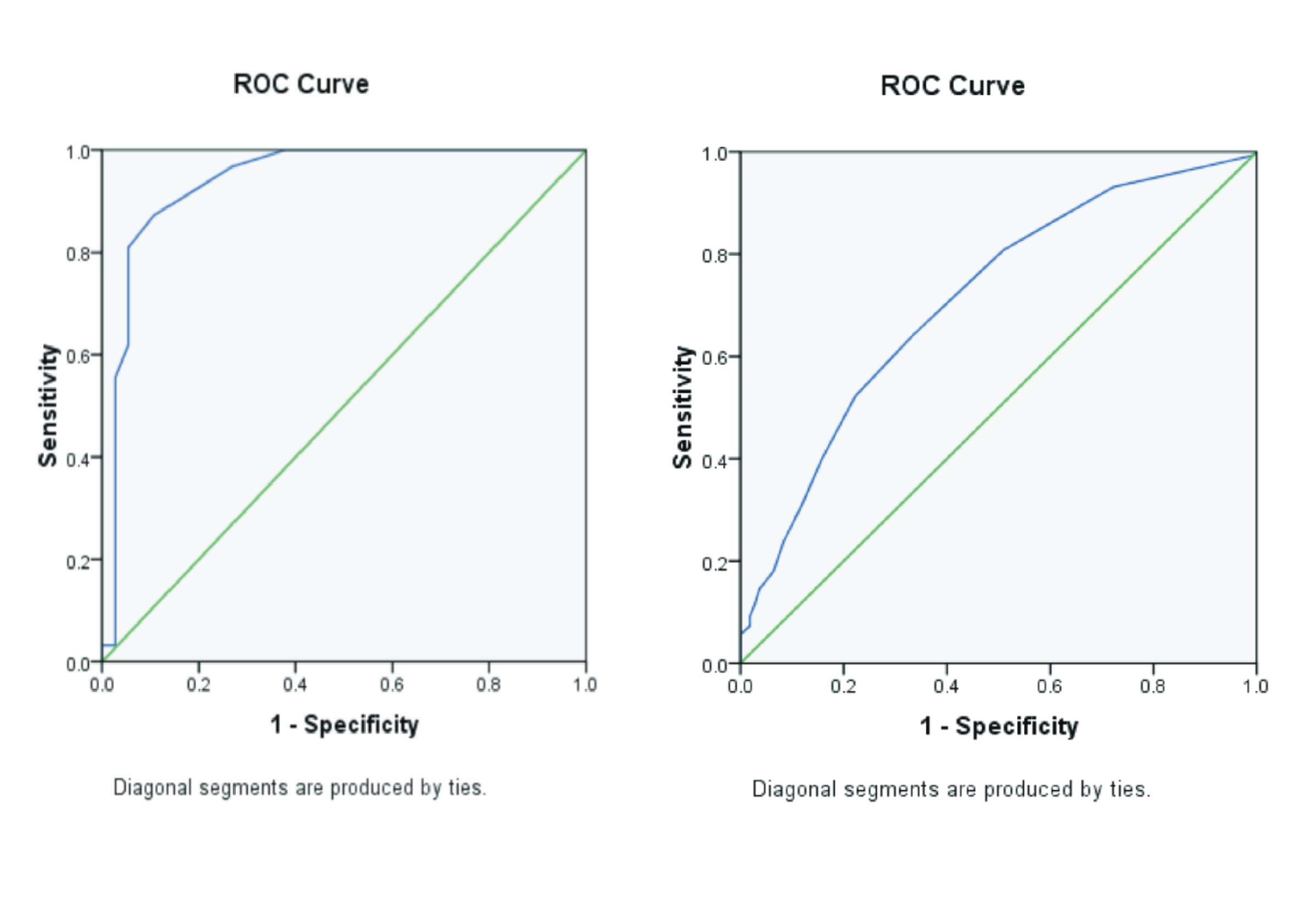EFFECT OF REPEATED FIRING OF PORCELAIN FUSED TO METAL ON PORCELAIN COLOR CHANGE

Background: The color of the porcelain surface is the main criterion for achieving perfect aesthetics. A factor that influences the color is the amount of firing of the porcelain. Purpose: To determine the color change of porcelain after repeated firing four times. Method: The research specimens consisted of 6 metals coated with Classic porcelain and 6 metals coated with Noritake porcelain and were subjected to four firing stages, then each stage was fired four times. The color change value was measured using VITA Easyshade. Statistical analysis using ANOVA. Result: The Classic and Noritake groups experienced a significant increase in color change from 1st to 2nd burning and from 1st to 3rd burning with a p-value < 0.05. There is a significant difference in the color change value based on the repetition of porcelain firing with a significance value of 0.000 < 0.05. There is a significant difference in the color change value based on porcelain products with a significant value of 0.020 < 0.05. There is no significant effect between repeated firing on porcelain and porcelain products in affecting the color change value with a significance value of 0.143 > 0.05. Conclusion: Both product groups experienced an increase in color change from firing 1st to 2nd and from firing 1st to 3rd. There was no increase in color change from firing 2nd to firing 3rd. There are significant differences in color change values based on porcelain products and there is no significant effect between repeated firing on porcelain and porcelain products on affecting color change values.
Introduction
A beautiful smile will look perfect if the teeth look neat, clean, aligned and as one of the most important aspects in communicating(Demirel & Tunçdemir, 2023). Teeth are an important organ in the body that has a chewing function that people use every day(Nuraeni & Fitriyani, 2023). Loss or damaged teeth will have an impact to the aesthetics, and it will affect the confidence aspect and social activities. Furthermore, teeth have function to masticate the food, maintain the perfect shape of the face, and also help pronunciation aspects in speaking(Afkhami et al., 2019),(Alfarisa, 2020). Loss of teeth can also occur, this causes the chewing process to become imperfect, which has an impact on digestive health(Siagian, 2016). Fixed restorations are one of the various types of restoration that can be an alternative replacement for missing teeth(Laoh et al., 2016). Fixed restoration can replace part or all of the tooth surface that has a problem or is damaged, one important factor that can affect the aesthetics of artificial teeth is the color of the material used(Amir Rad et al., 2015),(Demirel & Tunçdemir, 2023).
One of the materials to make fixed restorations is porcelain(Hidayatin et al., 2019). Fixed restoration made from porcelain material looks more natural and has superior biomechanics(Swapna et al., 2018),(Mohamed et al., 2020). Porcelain is a material made from kaolin, feldspar, silica and various pigments(Warreth & Elkareimi, 2020). Porcelain fused to metal restorations has a higher strength and hardness compared to all other porcelain restorations and the color is easily matched to the color of natural teeth(Gunawan et al., 2017),(Rosenstiel et al., 2006). The color of porcelain restoration is greatly influenced by the manufacturing process, expertise in combining porcelain core materials and firing temperature are the main factors to create aesthetic restorations(Kumar et al., 2017).
The process of making fixed restoration involves duplicating the morphological appearance of the natural teeth and is a complex process that requires careful control of shape, surface texture, and color(Swapna et al., 2018). The making of porcelain fused to metal restoration has many procedures and it can cause some errors, one of the procedures that must be carried out is building up with porcelain powder and firing(Manappallil, 2015). The firing process during the build-up process will affect the color change because repeated firing has a negative impact on the surface structure of the porcelain and causes discoloration(Yılmaz et al., 2014),(Swapna et al., 2018), the occurrence of color change can be influenced by the thickness of the porcelain layer(Elbasuny et al., 2021). One of the successes of dental technicians in making porcelain restoration is the stability of the porcelain color because this is a guarantee for the long term. The porcelain color measurement system can be done in several ways, including visual methods or observing objects directly or by using instruments or tools to measure the color of an object. In Commission Internationale de I'Eclairage L*, a*, b* (CIELab), L* represents value or lightness(Alnassar, 2022).
Based on the results of a preliminary study, porcelain firing was carried out more than five times, 36.4% stated this was done for porcelain color correction. This research is important to determine the color changes of porcelain fused to metal restoration. They are fired repeatedly so that the manufacturing procedure is carried out correctly to prevent correction of anatomical shape and color.
Material and Method
In this research, two types of porcelain were used, IPS Classic metal porcelain and Noritake metal porcelain. Each group consisted of six specimens, so total of 12 specimens were prepared. The shape of the specimen is a disk with 2 mm of thickness and the diameter is 10 mm(Yılmaz et al., 2014). Nickel-chrome (0.5 mm thickness), was used as a coating. The thickness of porcelain veneers was 1.5 mm then fired in an ivoclar programmat P300 furnace ovenFigure 1. Specimens were made from porcelain Classic®with A3 shade and porcelain Noritake® A3 shade are presented onFigure 2andFigure 3. This sample was made by porcelain fused to metal restoration method. There are two groups, the first uses materials porcelain Classic®shade A3, with first firing (as a control), the second firing and, the third firing as a treatment group, and the second group used porcelain Noritake®A3 shade with first firing (as control), second firing and third firing as treatment group.
In this research, color testing used VITA Easyshade®Figure 4and was carried out periodically. After the first stage of firing, color testing was carried out on both groups of porcelain as a control. After the second stage of firing, a second color test was carried out, and after the third stage of firing, a third color test was carried out.
Testing was carried out by placing the specimen in a mini-studio that had been given a white base with room lighting, then the tip was attached to the center of the specimen that had been determined. After that, the L*, a*, b* values that will appear on the tool monitor screen VITA Easyshade®were recorded. The values obtained were calculated using a Formula 1.
\( \documentclass{article} \usepackage{amsmath} \begin{document} \displaystyle \Delta E'
Afkhami, F., Elahy, S., Nahavandi, A.M., Kharazifard, M.J., Sooratgar, A., 2019. Discoloration of Teeth due to Different Intracanal Medicaments. Restorative Dentistry & Endodontics Vol. 44(1), Pp. e10.
Alfarisa, T., 2020. Estetika Restorasi Porcelain Fused to Metal pada Kasus Crossbite Anterior (Thesis). Universitas Airlangga.
Alnassar, T.M., 2022. Influence of Multiple Firings on The Color Stability and Surface Roughness of Gingival Pink Feldspathic Ceramic. Coatings Vol. 12(12), Pp. 1870.
Amir Rad, F.A., Succaria, F.G., Morgano, S.M., 2015. Fracture Resistance of Porcelain Veneered Zirconia Crowns with Exposed Lingual Zirconia for Anterior Teeth after Thermal Cycling: An in Vitro Study. Saudi Dental Journal. Vol. 27(2), Pp. 63-69.
Barnard, R.G., 2021. Sorption and Solubility of Denture Base Acrylic: A Comparative Surface Treatment Study (Thesis). Cape Peninsula University of Technology, Cape Town, South Africa.
Demirel, M., Tunçdemir, A., 2023. The Effect of Repeated Firings on The Color Change of Metal Based Ceramics Produced with Different Techniques. Necmettin Erbakan Universitesi Dis Hekimligi Dergisi ((Necmettin Erbakan University Dental Journal), Necmettin Erbakan Pp. 67-74.
Elbasuny, I.W., Shakal, M., Seddik, M., Elshahawy, W., 2021. The Effect of Repeating Firing Cycle on The Shade of Porcelain Fused to Metal, All-Ceramic and Zircona Restorations. Tanta Dental Journal Vol. 18(1), Pp. 20.
Gunawan, J., Takarini, V., Hasratiningsih, Z., 2017. Performa Porselen Fusi Logan dan Porselen Penuh. Jurnal Kedokteran Gigi Universitas Padjadjaran Vol. 29(3), Pp. 209-212.
Hidayatin, I., Indiani, S.R., Ratwita, R.D.F., 2019. Coping Manufactured Technique of Spinell Slip Cast All Ceramic by Conventional Methode and CAD/CAM. Journal of Vocational Health Studies Vol. 3(1), Pp. 32-36.
Katada, H., Inokoshi, M., Kamijo, S., Liu, H., Xu, K., Kawashita, M., Yokoi, T., Shimabukuro, M., Minakuchi, S., 2024. Effects of Multiple Firings on The Translucency, Crystalline Phase, and Mechanical Strength of Highly Translucent Zirconia. Dental Materials Journal Vol. 43(2), Pp. 294-302.
Kumar, K.R., Sukumar, R., Reddy, L.P., Pavan, T., Kiran, G., Navya, R., 2017. The Effect of Repeated Firing on The Color of Ceramic System with Two Different Veneering Porcelain Shades.
Laoh, M.H., Siagian, K.V., Ticoalu, S.H.R., 2016. Status Gingiva pada Pasien Pengguna Gigi Tiruan Cekat di RSGM PSPDG Fakultas Kedokteran Universitas Sam Ratulangi Manado. e-GiGi Vol. 4(2), Pp. 196-201.
Manappallil, J.J., 2015. Basic Dental Materials, 4th edn. JP Medical Ltd.
Mohamed, S., Ahmed, A., Mekkawi, W., 2020. Effect of Repeated Firings on The Color Change and Surface Roughness of Two All-ceramic Systems. Al-Azhar Dental Journal for Girls Vol. 7(1), Pp. 345-354.
Nuraeni, O., Fitriyani, F., 2023. Sistem Pakar Diagnosa Kondisi Gigi Tiruan menggunakan Metode Naïve Bayes Classifier. JIKA (Jurnal Informatika) Vol. 7(1),Pp. 79-88.
Özdemir, H., Duymus, Z.Y., 2019. The Effect of Laboratory Procedures and Repeated-Glazing on Color of Metal-Ceramic Restoration. Contemporary Clinical DentistryVol. 10(2), Pp. 239-242.
Rosenstiel, S.F., Land, M.F., Fujimoto, J., 2006. Contemporary Fixed Prosthodontics, 4th edn. Elsevier Health Sciences.
Siagian, K.V., 2016. Kehilangan Sebagian Gigi pada Rongga Mulut. e-CliniC Vol. 4(1), Pp. 1-6
Swapna, B., Shalini, K., Sreeramulu, B., 2018. Effect of Repeated Firings on The Color of Porcelain: An in Vitro Study. Indian Journal of Dental Advancements. Vol. 10(1), Pp. 21-29.
Tabatabaian, F., Khodaei, M.H., Namdari, M., Mahshid, M., 2016. Effect of Cement Type on The Color Attributes of A Zirconia Ceramic. The Journal of Advanced Prosthodontics Vol. 8(6), Pp. 449.
Ueda, N., Takagaki, T., Nikaido, T., Takahashi, R., Ikeda, M., Tagami, J., 2021. The Effect of Different Ceramic Surface Treatments on The Repair Bond Strength of Resin Composite to Lithium Disilicate Ceramic. Dental Materials Journal Vol. 40(5), Pp. 1073-1079.
Vichi, A., Corciolani, G., Carrabba, M., Munoz, A., Louca, C., 2023. Influence of Thickness of Opaque Porcelain and Alloy Color on The Final Color of Porcelain-Fused-to-Metal Restorations. Materials Vol. 16(1), Pp. 1-9.
Vita System, 5-04. VITA Easyshade®
Warreth, A., Elkareimi, Y., 2020. All-Ceramic Restorations: A Review of Literature. The Saudi Dental Journal Vol. 32(8), Pp. 365-372.
Yılmaz, K., Gonuldas, F., Ozturk, C., 2014. The Effect of Repeated Firings on The Color Change of Dental Ceramics using Different Glazing Methods. The Journal of Advanced Prosthodontics Vol. 6(6), Pp. 427.
Copyright (c) 2025 Journal of Vocational Health Studies

This work is licensed under a Creative Commons Attribution-NonCommercial-ShareAlike 4.0 International License.
- The authors agree to transfer the transfer copyright of the article to the Journal of Vocational Health Studies (JVHS) effective if and when the paper is accepted for publication.
- Legal formal aspect of journal publication accessibility refers to Creative Commons Attribution-NonCommercial-ShareAlike (CC BY-NC-SA), implies that publication can be used for non-commercial purposes in its original form.
- Every publications (printed/electronic) are open access for educational purposes, research, and library. Other that the aims mentioned above, editorial board is not responsible for copyright violation.
Journal of Vocational Health Studies is licensed under a Creative Commons Attribution-NonCommercial-ShareAlike 4.0 International License














































